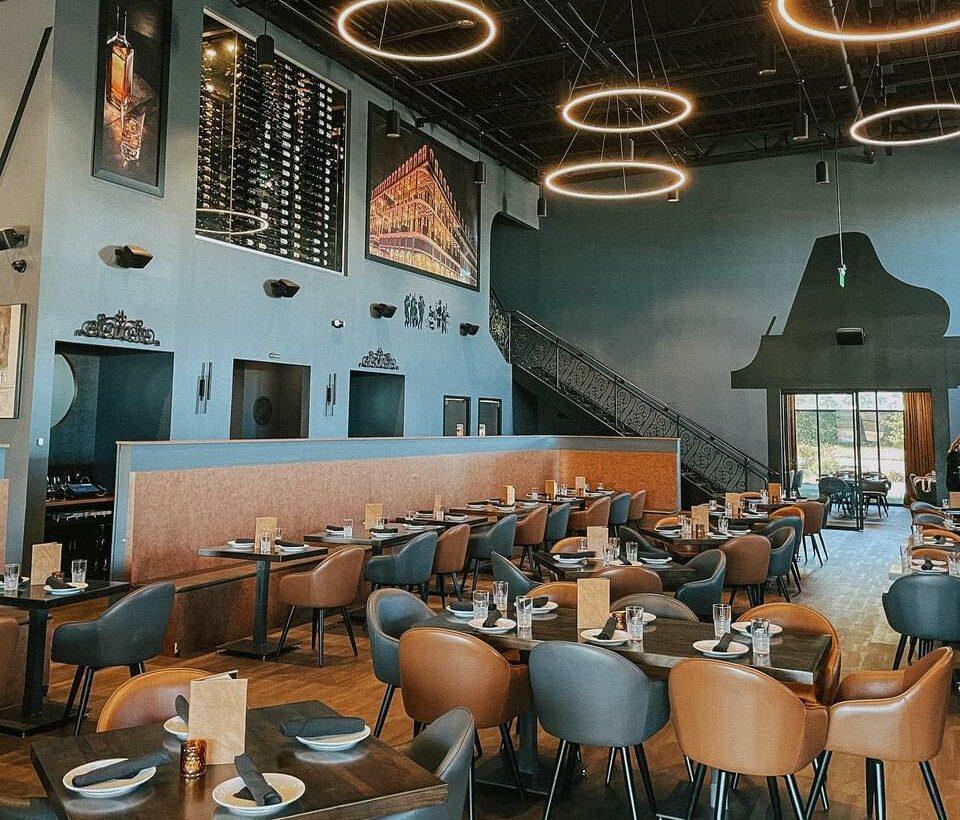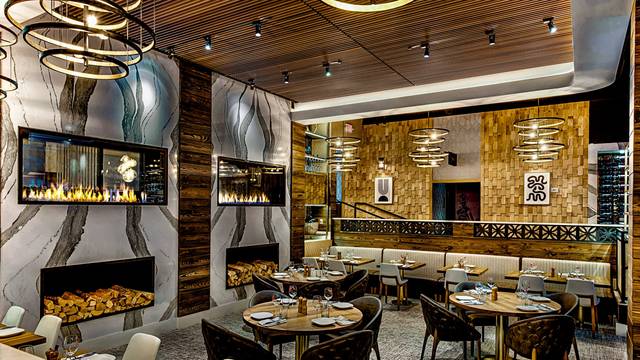Fine Dining Experience Islamabad: Enjoy Elegant Cooking Delights
Wiki Article
Savor Authentic Asian Cuisine With a Pan-Asian Twist for a Culinary Adventure
Starting a culinary trip via genuine Oriental cuisine, boosted with a Pan-Asian spin, offers an unique opportunity to discover the rich tapestry of flavors that specify the area's diverse cooking practices. This experience invites you to savor the elegant equilibrium of preferences-- sweet, salted, spicy, and sour-- integrated by fragrant herbs and spices. Think of the ingenious fusion of Thai curry and ramen or the unexpected delight of sushi burritos. As you ponder these luring dishes, think about the cultural stories and historical impacts that form them, each bite using a tale waiting to be uncovered.
Checking Out Pan-Asian Flavors
In the world of global gastronomy, Pan-Asian cuisine stands apart for its remarkable diversity and the unified interaction of tastes from various Oriental cultures. This cooking strategy commemorates the rich customs and distinct active ingredients located throughout the continent, developing a tapestry of preferences that is both appealing and enjoyable. Key to Pan-Asian food is its capability to stabilize different tastes-- pleasant, salty, spicy, and sour-- while highlighting the freshness and high quality of each active ingredient.From the umami-rich soy sauce of Japan to the intense chili peppers of Thailand, Pan-Asian cuisine provides a comprehensive scheme of flavors. These aspects are usually combined in innovative methods, boosting recipes with layers of intricacy. For example, making use of great smelling natural herbs such as lemongrass and cilantro, usual in Vietnamese and Thai food, includes a rejuvenating brightness to dishes, while the consolidation of coconut milk supplies a velvety, abundant appearance.
The emphasis on fresh fruit and vegetables and fragrant flavors makes certain that each dish is not only a feast for the palate yet additionally for the senses. Pan-Asian cuisine welcomes restaurants to start a culinary trip, checking out the large and varied landscapes of Eastern gastronomy with every bite.
Combination Meals to Try
While Pan-Asian cuisine is commemorated for its conventional tastes, the modern cooking landscape is increasingly welcoming blend dishes that mix these timeless elements with influences from various other areas. This cutting-edge approach not just honors the rich heritage of Oriental cooking arts but additionally presents novel preference experiences that interest contemporary tastes.
A prime example of such a blend dish is the Korean-Mexican taco, where marinaded bulgogi beef is covered in a warm tortilla, covered with kimchi and a hot gochujang-infused salsa. This mix weds the strong, mouthwatering tastes of Korea with the lively, fresh components of Mexican cuisine. Similarly, sushi burritos have acquired popularity, integrating the fragile creativity of Japanese sushi with the passionate, hand-held comfort of a burrito, frequently featuring combination components like tempura shrimp and avocado with a drizzle of wasabi mayo.
One more notable meal is Thai curry ramen, which instills the luscious, fragrant flavors of Thai curry right into the soothing broth of standard Japanese ramen, producing an unified mix that entices the detects. These combination meals prolong beyond simple novelty; they represent a culinary dialogue between cultures, motivating exploration and technology in the globe of Pan-Asian food.
Crucial Active Ingredients and Seasonings
To absolutely value Pan-Asian food, one need to comprehend the vital ingredients and spices that develop its structure. This varied culinary design draws from a rich tapestry of Asian practices, using a harmonious blend of tastes and structures. Secret ingredients consist of soy sauce, fish sauce, and oyster sauce, which give a full-flavored umami deepness necessary to Oriental dishes. Complementary to these are rice vinegar and mirin, lending a fragile level of acidity and sweetness.Fragrant elements are essential, with lemongrass, ginger, and garlic being ubiquitous throughout various Pan-Asian dishes. These ingredients offer a great smelling base that enhances the complexity of tastes. Spices such as star anise, cardamom, and cinnamon present heat and character, echoing impacts from areas like China and India.

Food Preparation Techniques and Tips
Mastering the art of Pan-Asian cuisine requires familiarity with its distinctive food preparation strategies, each adding to the vivid tapestry of tastes this cooking custom is celebrated for. Central to these techniques is the stir-fry, a fast cooking technique that preserves the nutritional honesty and vivid shades of ingredients. Utilizing a wok, the stir-fry method enables also warmth distribution, crucial for attaining the particular structure and flavor balance of Pan-Asian dishes.An additional basic method is steaming, especially prevalent in Chinese cuisine. This mild approach preserves the natural tastes and nutrients of active ingredients, making it excellent for fish and shellfish and vegetables. Dumplings, a cherished staple, frequently gain from steaming, causing soft, delicious structures.
Barbecuing, likewise essential, imparts great smoky midsts to meals such as Korean bulgogi or Japanese yakitori (best asian restaurant Islamabad). This method commonly entails seasoning ingredients, allowing flavors to penetrate deeply prior to cooking over an open fire or hot plate
Last but not least, mastering the art of balancing tastes-- pleasant, sour, salted, bitter, and umami-- is vital. Appropriately layering these components can elevate a dish from regular to phenomenal, providing a complex and satisfying culinary experience that personifies the significance of Pan-Asian food.
Dining Experiences Worldwide
Across the globe, Pan-Asian food provides an unequaled eating experience, commemorated for its abundant tapestry of tastes and lively presentations. This cooking sensation has gone beyond cultural boundaries, capturing the hearts and palates of food enthusiasts worldwide. In multicultural cities like New York, London, and Sydney, Pan-Asian dining establishments offer as melting pots where culinary customs from Thailand, Japan, China, and beyond assemble, supplying restaurants with a diverse mix of recipes that highlight the area's diversity.The worldwide allure of Pan-Asian cuisine depends on its ability to provide both authenticity and advancement. Cooks masterfully marry traditional components such as lemongrass, soy sauce, and miso with modern techniques, causing dishes that are both refreshingly brand-new and familiar. This fusion allows diners to start a culinary journey that appreciates heritage while embracing modernity.
In addition, dining experiences are raised with attentively created environments that reflect the values of Pan-Asian aesthetics. From minimal Japanese-inspired interiors to dynamic Thai-themed areas, each dining establishment offers an one-of-a-kind ambiance that enhances the culinary offerings. Consequently, customers are not merely eating a meal but partaking in a Romantic restaurants Islamabad cultural experience, making Pan-Asian dining an absolutely global sensation.
Final Thought
The exploration of Pan-Asian food provides an extensive understanding of the elaborate interplay of flavors and culinary traditions across Asia. By welcoming blend recipes such as Thai curry ramen and sushi burritos, the culinary journey not only highlights the adaptability of standard active ingredients but also showcases ingenious modern strategies. This gastronomic journey, enhanced by crucial seasonings and cooking approaches, gives a special opportunity to appreciate the social diversity and cooking artistry that define Pan-Asian cuisine on an international scale.Embarking on a culinary trip via genuine Oriental food, improved with a Pan-Asian twist, provides an unique possibility to explore the abundant tapestry of flavors that specify the area's varied culinary traditions.In the world of international gastronomy, Pan-Asian cuisine stands out for its amazing variety and the harmonious interaction of tastes from different Asian cultures. Key to Pan-Asian cuisine is its capacity to stabilize different tastes-- wonderful, salted, spicy, and sour-- while highlighting the freshness and top quality of each active ingredient.

Report this wiki page